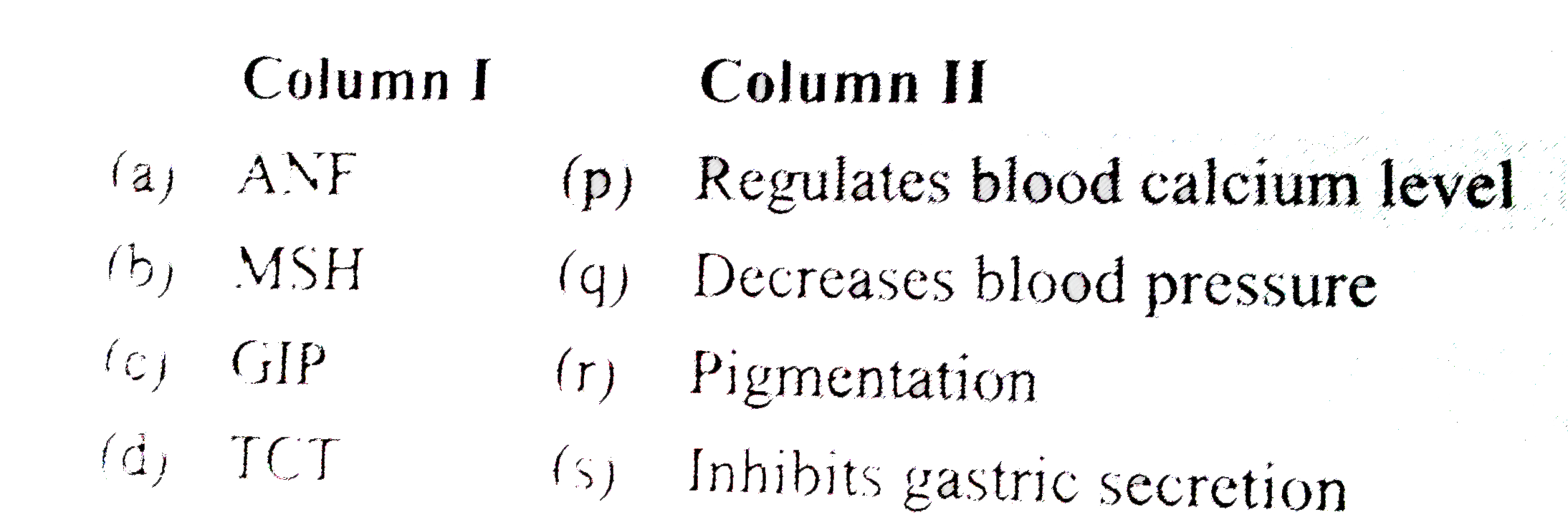Match the columns and choose correct options.

(1) a-q, b-r, c-s, d-p
(2) a-s, b-p, c-q, d-r
(3) a-q, b-p, c-s, d-r
(4) a-s, b-p, c-r, d-q
a-q, b-r, c-s, d-p
a-s, b-p, c-q, d-r
a-q, b-p, c-s, d-r
a-s, b-p, c-r, d-q
The correct Answer is:A
Step by step video & image solution for Match the columns and choose correct options. (1) a-q, b-r, c-s, d-p (2) a-s, b-p, c-q, d-r (3) a-q, b-p, c-s, d-r (4) a-s, b-p, c-r, d-q by Biology experts to help you in doubts & scoring excellent marks in Class 12 exams.
Updated on:21/07/2023Topper's Solved these Questions
- CHEMICAL COORDINATION AND REGULATIONBOOK - DINESH PUBLICATION ENGLISHCHAPTER - CHEMICAL COORDINATION AND REGULATIONEXERCISE - Check Your Grasp
10 Videos
- CHEMICAL COORDINATION AND REGULATIONBOOK - DINESH PUBLICATION ENGLISHCHAPTER - CHEMICAL COORDINATION AND REGULATIONEXERCISE - Brain Teasers-V
114 Videos
- CELL CYCLE (CELL DIVISION)BOOK - DINESH PUBLICATION ENGLISHCHAPTER - CELL CYCLE (CELL DIVISION)EXERCISE - BRAIN TEASERS-III
85 Videos
- CHORDATA- PROTOCHORDATABOOK - DINESH PUBLICATION ENGLISHCHAPTER - CHORDATA- PROTOCHORDATAEXERCISE - CYG
11 Videos
Similar Questions
Match te columns

(1) a-s, b-t, c-r, d-p
(2) a-t, b-q, c-r, d-p
(3) a-t, b-r, c-q, d-p
(4) a-t, b-r, c-p, d-q
View SolutionConsider
∫x3+3x2+2x+1√x2+x+1dx
=(ax2+bx+c)√x2+x+1+λ∫dx√x2+x+1
Now, match the following lists and then choose the correct code.

Codes:
abcd(1)qpsr(2)spqr(3)rqps(4)qspr
View SolutionMatch the following lists (where [x] represents the greatest integer function) and then choose the correct code.

Codes :
a b c d(1)s r q p(2)q p s p(3)s r p q(4)p p q r
View SolutionIf A={a,b, c,d}, B={p,q,r,s} than Is the following relation from A → B? Give reasons for your answer.: R3={(a,p), (a,q), (d,p), (c,r), (b,r)}
View SolutionFind derivative of the following functions (it is to be understood that a, b, c, d, p, q, r and s are fixed non-zero constants and m and n are integers): (px+q)(rx+s)
View SolutionFind derivative of the following functions (it is to be understood that a, b, c, d, p, q, r and s are fixed non-zero constants and m and n are integers): ax+bpx2+qx+r
View SolutionFind derivative of the following functions (it is to be understood that a, b, c, d, p, q, r and s are fixed non-zero constants and m and n are integers): px2+qx+rax+b
View SolutionIf p+q+r=0=a+b+c, then the value of the determinant ∣∣ ∣ ∣∣paqbrcqcrapbrbpcqa∣∣ ∣ ∣∣is (a)0 (b) pa+qb+rc (c) 1 (d) none of these
View SolutionThe point P(a,b), Q(c,d), R(a,d) and S(c,b) , where a,b,c ,d are distinct real numbers, are
View SolutionThe roots of the equation (q−r)x2+(r−p)x+p−q=0 are (A) r−pq−r,1 (B) p−qq−r,1 (C) q−rp−q,1 (D) r−pp−q,1
View Solution
